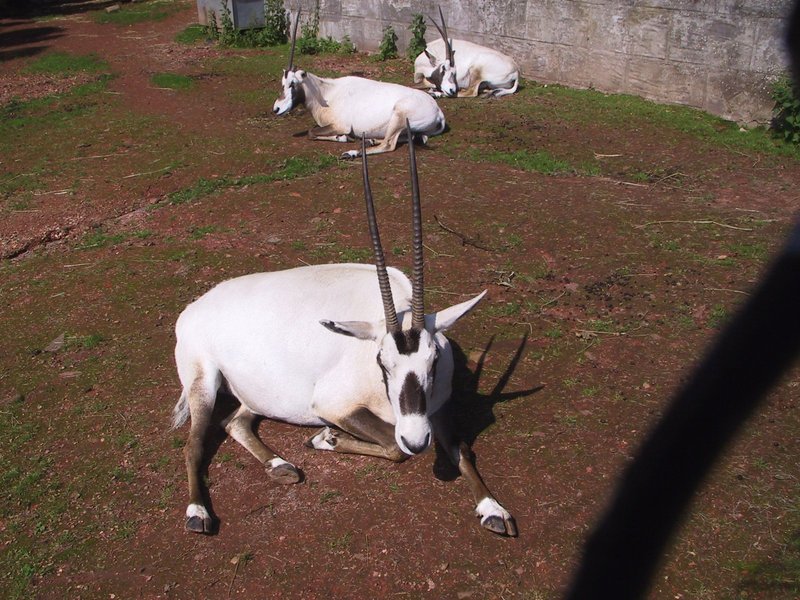Arabian Oryx (Oryx leucoryx) - Wiki Arabian Oryx
From Wikipedia, the free encyclopedia
[Photo] Arabian Oryx (Oryx leucoryx). Original comment: "The oryx is a beautiful antelope species. There are several black and white Arabian oryx in Edinburgh Zoo." Photographer: alisdair. Source : flickr (http://www.flickr.com/photos/alisdair/3704099/)
The Arabian Oryx (Oryx leucoryx) is a bovid and the smallest member of Oryx genus, native to desert and steppe areas of the Arabian peninsula. An endangered species, the Arabian Oryx was largely extinct in the wild by the early 1970s; reintroduction programs have since been attempted, with mixed success.
Arabian Oryx stand about a metre high at the shoulder and weigh around 70 kilograms (about 154lbs). Their coats are an almost luminous white, their undersides and legs are brown, and there are black stripes where the head meets the neck, on the forehead, on the nose and going from the horn down through the eye to the mouth. Both sexes have long straight ringed horns which reach just over half a metre.
Arabian Oryx eat buds, grass and leaves. Arabian Oryx rest during the heat of the day and can detect rainfall and will move towards it, meaning that they have huge ranges, a herd in Oman ranging over 3,000 square kilometres. Herds are of mixed sex and contain between two and fifteen animals.
A Qatari Oryx named "Orry" was chosen as the official Games mascot for the 2006 Asian Games in Doha.
The Bible uses the Hebrew word re’em for the Arabian Oryx, although this word may also refer to the Aurochs. The legend of the Unicorn probably originated in part from the Arabian Oryx, which when seen in profile frequently appears to have only a single horn. In the King James Version of the Bible the word “re’em” is translated as “unicorn”.
Disappearance and reintroduction
Arabian Oryx were hunted to extinction in the wild by 1972. Attempted reintroduction began in Oman as early 1982, but numbers there have declined, from 450 in 1996 to 106 by early 2003 (with an effective breeding size considered much smaller) due to illegal live capture and the increasing size of herds in Saudi Arabia. Saudi Arabia saw an increase from 400 in 1997 to approximately 700 by early 2003, along with a small increase in the population in Israel. In 2007 the United Arab Emirates released 100 Arabian Oryx into the Abu Dhabi desert, part of a five year plan to reintroduce 500 by 2012.
The Phoenix Zoo is credited with saving the Arabian Oryx from extinction. In 1962 they started the first captive-breeding herd in any zoo. Starting with only 9 animals, the Phoenix Zoo has had over 200 successful births. Oryx were sent to other zoos to start their herds. By 1990, the number of Arabian Oryx had increased to over 1300 including 112 captive bred ones which were reintroduced back to the wild in preserves in their native lands.
On June 28, 2007 Oman's Arabian Oryx Sanctuary became the first UNESCO World Heritage Site to be removed from the World Heritage List in light of the Omani government's decision to reduce the Oryx's habitat by 90%. The Omani population of wild Oryx has dwindled from 450 in 1996, to less than 65 in 2007 (with fewer than four viable breeding pairs) due to poaching and habitat degredation. Plans to open the area to oil prospecting led UNESCO to conclude that the Omani habitat is no longer viable. http://whc.unesco.org/en/news/362
http://en.wikipedia.org/wiki/Arabian_Oryx
| The text in this page is based on the copyrighted Wikipedia article shown in above URL. It is used under the GNU Free Documentation License. You may redistribute it, verbatim or modified, providing that you comply with the terms of the GFDL. |
